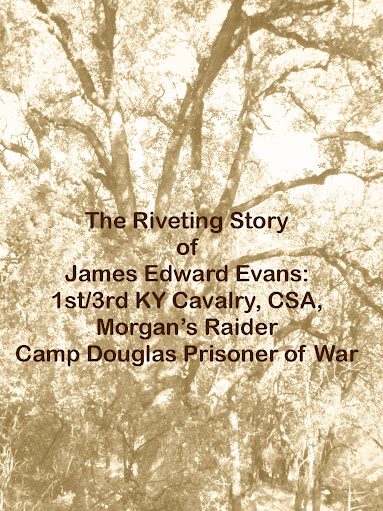The roots of the “farmers and horse thieves” story lay with my grandfather’s namesake, James Edward Evans.
“The last time I saw my father, he told me that he was supposed to have been named for his grandfather, James Edward Evans. However, the doctor heard 'James Earl Evans' when his mother gave the doctor his name to enter into the records, and this country family did not have the nerve to contradict the doctor and change the child's name to what it should have been.”
~ Dave Evans. [i]
James Edward Evans, my 2nd great-grandfather, was born May 23, 1841. He was the fifth of the fifteen children born to Dr. Isaac Greenup Evans and his wife Sarah “Sally” Barkley. While the story of their meeting is lost to history, it is possible that Isaac Greenup Evans met Sarah while he was traveling to Virginia for his medical education. [ii] Many of the oldest of the Evans family alliances, such as with the Edmondsons, Stevens, and Chandlers, harkened back to earlier days in Virginia. It is highly likely that these families immigrated into Kentucky together shortly after the conclusion of the Revolutionary War.
The Wilderness Road, the most frequently traveled immigrant path, ran from the Shenandoah Valley into the heartlands of Kentucky. Once the path reached Harrodsburg, Kentucky, it meandered through Anderson County along a ridge between Chaplin Fork and the Town Fork of Salt River, before forging onward to the headwaters of the East Fork of Cox’s Creek in Nelson County. [iii] Modern highways still follow the route of the Wilderness Trail.
“U.S. 62 probably follows its route closely as far as Bloomfield. State Route 48 follows it from Bloomfield through Fairfield along the East Fork of Cox’s Creek to Highgrove on U.S. 31-E. From Highgrove, it continued along the East Fork of Cox’s Creek through Bullitt County to Solitude, where it forded the main stream of Cox’s Creek.”[iv]
In 1860, the infant mortality rate in the United States was 13 percent.[v] The average life expectancy for men was 38.7 years, for women 40.9 years.[vi] While Isaac Greenup Evans had become a physician, he was helpless to prevent death from claiming a full third of his children in a mere five year span. His two eldest daughters succumbed to consumption. Cordelia died in 1852 just seven months after her marriage to Alexander Crawford and Sarah Ann died in 1855 two years after her marriage to Henry F. Gray. Likewise, three of the youngest children, Robert age 7, Ellen age 4, and Dudley age 3 died of scarlet fever during the winter of 1857.[vii]
“Thursday, December 4, 1851
Married on the 27th, by Rev. A. K. Cox, Alexander Crawford & Miss Cordelia F. Evans, both of Nelson County.” [viii]
“Cordelia Crawford, 19 years, b: Nelson County, daughter of Isaac G. and Sarah Evans, died 6/24/1852 at Caney Fork of Consumption.” `~ Nelson County Pioneer 1852
“Wednesday June 30, 1852
Mrs. Cordelia F. Crawford, died on the 24th of pulmonary consumption, at the home of her father Isaac G. Evans. Was the consort of Alexander Crawford. Was recently married. Member of the Methodist E. Church.” [ix]
“Thursday, February 24, 1853
Married Feb. 17, by Rev A. K. Cox, Henry Gray of Perryville, Boyle Co., & Miss Sallie Ann Evans of Nelson Co.”[x]
The Evans family farm, northeast of Bardstown, Kentucky in the vicinity of Plum Run Road and the Caney Fork, provided the family with a comparatively comfortable lifestyle. Slaves and hired laborers tended both the tobacco and the basic needs of the family. Although they weren’t among the large slave owners, land barons, or members of elite society; they had enough land, money, and slaves to be considered affluent. [xi] In today’s terms, the Evans were an upper middle class family.
The days of plenty were not to last. Misfortune struck the nation in 1857 with an economic depression. Inflamed by the fractured economy, long simmering tensions flared between the North and South. When resolution could not be reached, Southern states acted upon their threat of succession. The Union was ripped asunder.
While Kentucky pled neutrality, its citizens were inevitably swept away in the uncontainable tides of the Civil War. Confederate and Union troops, as well as raucous bands of Partisan Rangers, crisscrossed the state commandeering food, horses, and every other supply needed for the survival of an army. It is nearly impossible for a private citizen to remain neutral when his crops have been ruined, horses stolen, and smoke houses looted. A mother can not be expected to remain placid when unwelcome soldiers push across her families’ doorstep and frighten her children. To understand what befell the Evans family and their response to these incidences, one must first understand the historical events and political climate of the period.
ENDNOTES
[i] J. David Evans, [Internet-E-mail], 7 Aug 2006.
[ii] Perrin, Battle, Kniffin, “Kentucky: A History of the State,” 4th ed., 1887.
[iii] McDowell, Robert E.“The Wilderness Road’s Louisville End,” The Courier-Journal Magazine, March 6, 1962.
[iv] Ibid.
[v] Lewontin, Richard C. “Biology As Ideology,” 1991,p. 42 .
[vi] United States Department of Commerce. Historical Statistics of the United States: Colonial Times to 1970, Part 1. Washington D.C.: United States Government Printing Office, 1975.
[vii] Ingmire,Frances Terry. “Nelson County, Ky. Death Records” c. 1983, Lillian Ockerman, “Nelson County, KY. Marriages, Bonds, Consents, and Minister's Returns.”
[viii] Wimp, Carolyn “Abstracts of Nelson County, KY Newspapers Sept 1807 -Sept 1890” p. 43.
[ix] Ibid. p 45.
[x] Ibid. p 51
[xi] 1860 Kentucky Census Nelson County, District 1 , lines 9 - 19; 1870 Census of Nelson Co, Bardstown Pct 1, p 20; Evans Family Bible, Abstracts of Deeds 1785-1808 Nelson Co. KY, Nelson Co. His. Soc., p 185: Deed book 6 p 730, Deed Book G, p 254, p 302, Slave Schedules 1850 Kentucky, Nelson County, District 1: lines 24 - 29, Slave Schedules 1860 Kentucky, Nelson County, District 1,lines 33- 40.
Sunday, October 12, 2008
Subscribe to:
Post Comments (Atom)





No comments:
Post a Comment